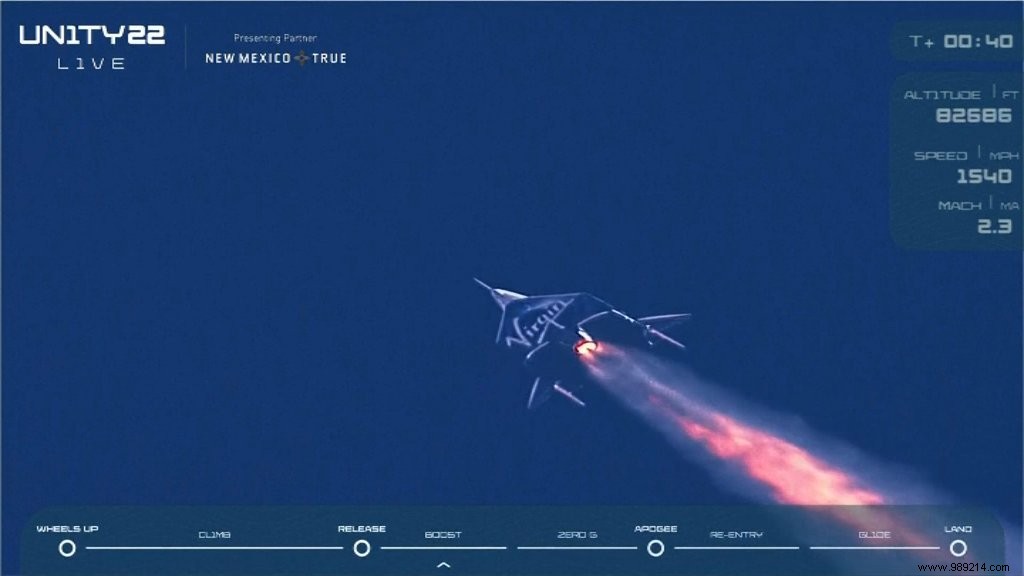According to a New Yorker report, the first tourist flight operated by the Virgin Galactic company, which included company founder Richard Branson, could have gone very wrong . What exactly do we know about this incident?
Virgin Galactic operated its first official crewed mission on July 11. On board the VSS Unity suborbital plane, dropped from high altitude by its carrier plane, the crew was able to experience four minutes of weightlessness before descending to Earth. If the mission was indeed presented as a real success, it seems that in the end everything did not go as planned.
During flight, near the end of the VSS Unity engine burn sequence, a yellow light would indeed appear on a console. This light told the company's veteran pilots, Dave Mackay and Mike Masucci, that the aircraft was beginning to drift off course . A few seconds later, another warning light, red this time, appeared on the console.
The two pilots then had to make a decision in a split second:to shut down the rocket engine and return to Earth in a perilous emergency landing or to take immediate action to solve their trajectory problem.
This scene is described in a new report by Nicholas Schmidle, in The New Yorker . As part of writing his book titled Test Gods , the journalist had benefited from privileged access to Virgin Galactic, and in particular to this flight project for space.
In his book, he explains that he attended a meeting in 2015 in which the pilots of the July 11 mission and others discussed the procedures to follow in the event of a warning by these famous seers. CJ Sturckow, a former NASA astronaut, reportedly told pilots at the time that a yellow light should "scare you because a red light would indicate that it was "already too late “.
During the flight of the VSS Unity, the pilots therefore chose to continue despite this warning. Rather than cutting the engine, the two pilots would have tried to put the vehicle back on a safe upward trajectory so that he would be able to return safely to Earth afterwards, which they did at the risk of potentially putting the lives of the crew members at risk.
In the meantime, the VSS Unity would have flown outside of its designated airspace for 1 minute 41 seconds, or more than 10% of its flight time after being dropped from his carrier plane. The Federal Aviation Administration (FAA) is currently investigating the incident.

Here is what this story published in The New Yorker tells us in broad terms . Following its publication, however, Virgin Galactic issued the following statement:"We dispute the misleading characterizations and conclusions of the article. […]The safety of our crew and passengers is Virgin Galactic's top priority “.
“Unity 22 was a safe and successful test flight that adhered to our flight procedures and training protocols “, continues the statement. “When the vehicle encountered high altitude winds that altered the trajectory, the pilots monitored the trajectory to ensure it remained within mission parameters . Our pilots reacted appropriately to these changing flight conditions. […] Although the ultimate trajectory of the flight has deviated from our initial plan , it was a controlled and intentional flight path which allowed Unity 22 to reach space and land safely in our spaceport in New Mexico. At no time were the passengers and crew endangered by this change in trajectory “.
And ending with:"As we move towards a commercial service, we are confident that we have the security culture, policies and processes in place. appropriate to build and operate a safe and successful long-term business “.
Recall that this is not the first time that a Virgin Galactic mission has encountered potentially dangerous technical difficulties. A pilot paid a high price for it in 2014 during a previous test flight. During another test flight in July 2018, pilots Mackay and Masucci also lost control of their aircraft as they flew through Earth's mesosphere. As the New Yorker recalls, however, they managed to regain control and land safely.
Mark Stucky, another Virgin Galactic pilot, was also recently fired by the company after raising concerns about the company's security practices in a published book in May by Nicholas Schmidle.